1996 CADILLAC SEVILLE reset
[x] Cancel search: resetPage 176 of 354
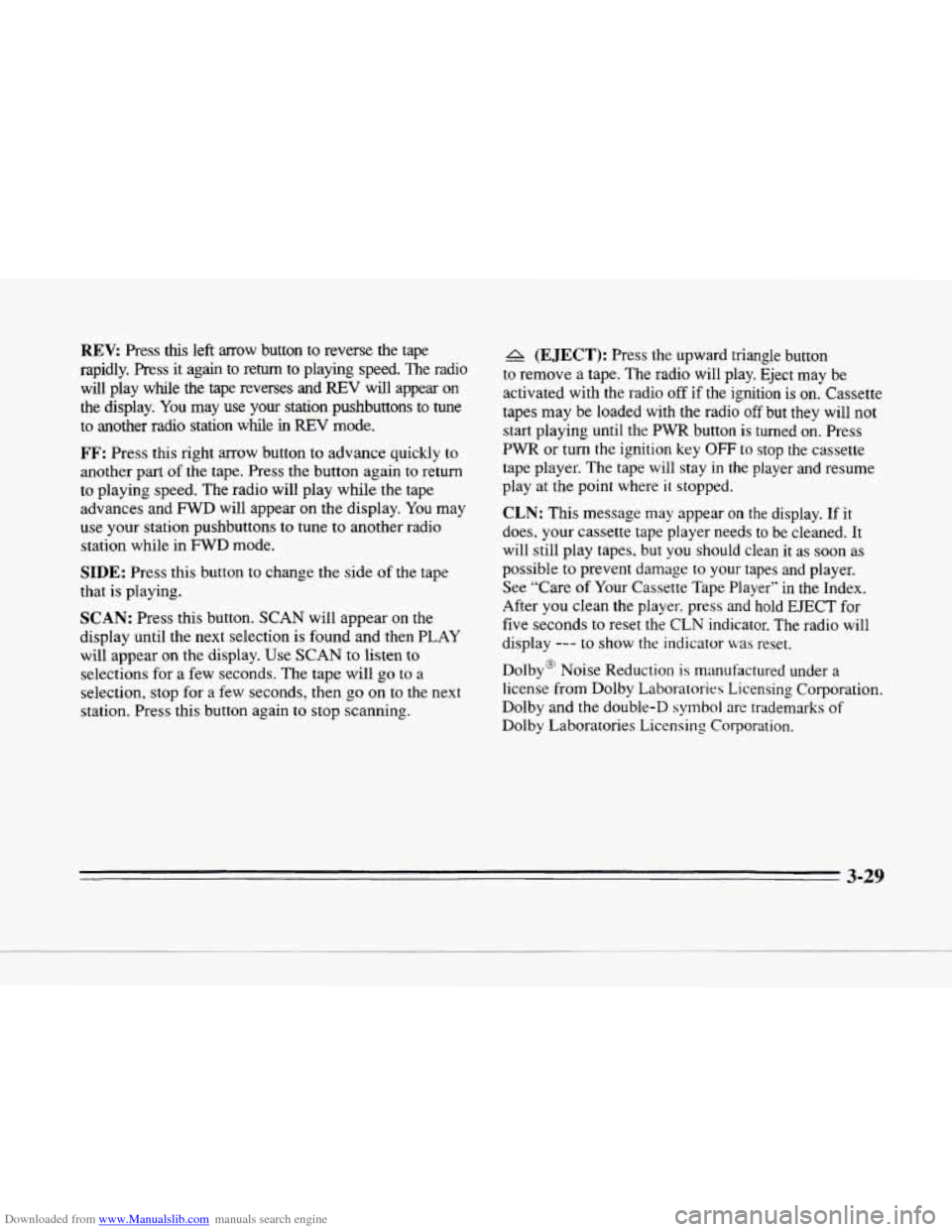
Downloaded from www.Manualslib.com manuals search engine c
F-.
REV: Press th~s left arrow button to reverse the tape
rapidly. Press
it again to return to playing speed. The radio
will play wMe the
tape reverses and REV will appear on
the display. You may use your station pushbuttons to tune
to another radio station while in REV mode.
FF: Press this right arrow button to advance quickly to
another part of the tape. Press the button again to return
to playing speed. The radio will play while the tape
advances and FWD will appear on the display. You may
use your station pushbuttons
to tune to another radio
station while in FWD mode.
SIDE: Press this button to change the side of the tape
that
is playing.
SCAN: Press this button. SCAN will appear on the
display until the next selection is found and then PLAY
will appear on the display. Use
SCAN to listen to
selections for a few seconds. The tape will go to a
selection, stop for a few seconds, then go on to the next
station. Press this button again
to stop scanning.
A (EJECT): Press the upward triangle button
to remove a tape. The radio will play. Eject may be
activated with the radio off
if the ignition is on. Cassette
tapes may be loaded with the radio
off but they will not
start playing until the
PWR button is turned on. Press
PWR or turn the ignition key OFF to stop the cassette
tape player. The tape will stay in
the player and resume
play at
the point where it stopped.
CLN: This message may appear on the display. If it
does, your cassette tape player needs to be cleaned.
It
will still play tapes, but you should clean it as soon as
possible to prevent damage to your tapes and player.
See “Care of Your Cassette Tape Player” in the Index.
After you clean the player, press and hold EJECT for
five seconds to reset the CLN indicator. The radio will
display
--- to show the indicator was reset.
Dolby“ Noise Reduction
is manufactured under a
license from Dolby Laboratories Licensing Corporation.
Dolby and the double-D
symbol are trademarks of
Dolby Laboratories Licensing Corporation.
3-29
Page 179 of 354
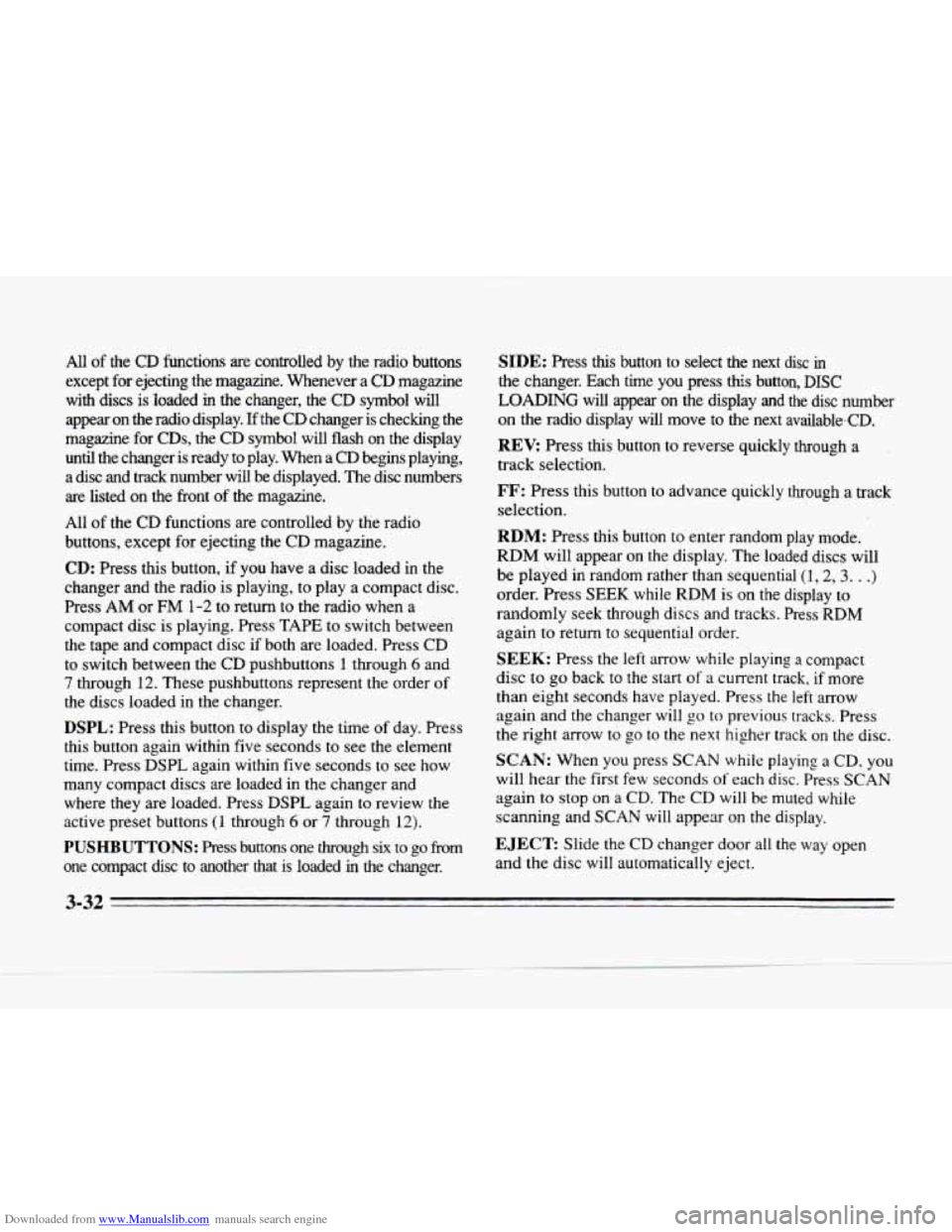
Downloaded from www.Manualslib.com manuals search engine All of the CD functions are controlled by the radio buttons
except for ejecting the magazine. Whenever
a CD magazine
with discs is loaded
in the changer, the CD symbol will
appear on the radio display.
If the CD changer is checking the
magazine for
CDs, the CD symbol will flash on the display
until the changer is ready to play. When a
CD begins playing,
a disc and track number will be displayed. The disc numbers
are listed on the front of the magazine.
All
of the CD functions are controlled by the radio
buttons, except for ejecting the CD magazine.
CD: Press this button, if you have a disc loaded in the
changer and the radio is playing, to play a compact disc.
Press AM or
FM 1-2 to return to the radio when a
compact disc is playing. Press TAPE to switch between
the tape and compact disc
if both are loaded. Press CD
to switch between the CD pushbuttons 1 through 6 and
7 through 12. These pushbuttons represent the order of
the discs loaded in the changer.
DSPL: Press this button to display the time of day. Press
this button again within five seconds to see the element
time. Press DSPL again within five seconds to see how
many compact discs
are loaded in the changer and
where they are loaded. Press
DSPL again to review the
active preset buttons
(1 through 6 or 7 through 12).
PUSHBUTTONS: Press buttons one through six to go from
one compact disc to another that is loaded
in the changer.
SIDE: Press this button to select the next disc in
the changer. Each time you press this button, DISC
LOADING will appear on the display and the disc number
on the radio display will move to the next available-CD.
REV: Press this button to reverse quickly through a
track selection.
FF: Press this button to advance quickly through a track
selection.
RDM: Press this button to enter random play mode.
RDM will appear on the display. The loaded discs will
be played
in random rather than sequential (1,2,3. . .)
order. Press SEEK while RDM is on the display to
randomly seek through discs and tracks. Press RDM
again
to return to sequential order.
SEEK: Press the left arrow while playing a compact
disc to go back to the start
of a current track, if more
than eight seconds have played. Press the
left arrow
again and the changer
will go to previous tracks. Press
the right arrow to
go to the next higher track on the disc.
SCAN: When you press SCAN while playing a CD, you
will hear the first few seconds
of each disc. Press SCAN
again to stop on a CD. The CD will be muted while
scanning and
SCAN will appear on the display.
EJECT Slide the CD changer door all the way open
and the disc will automatically eject.
3-32
Page 180 of 354
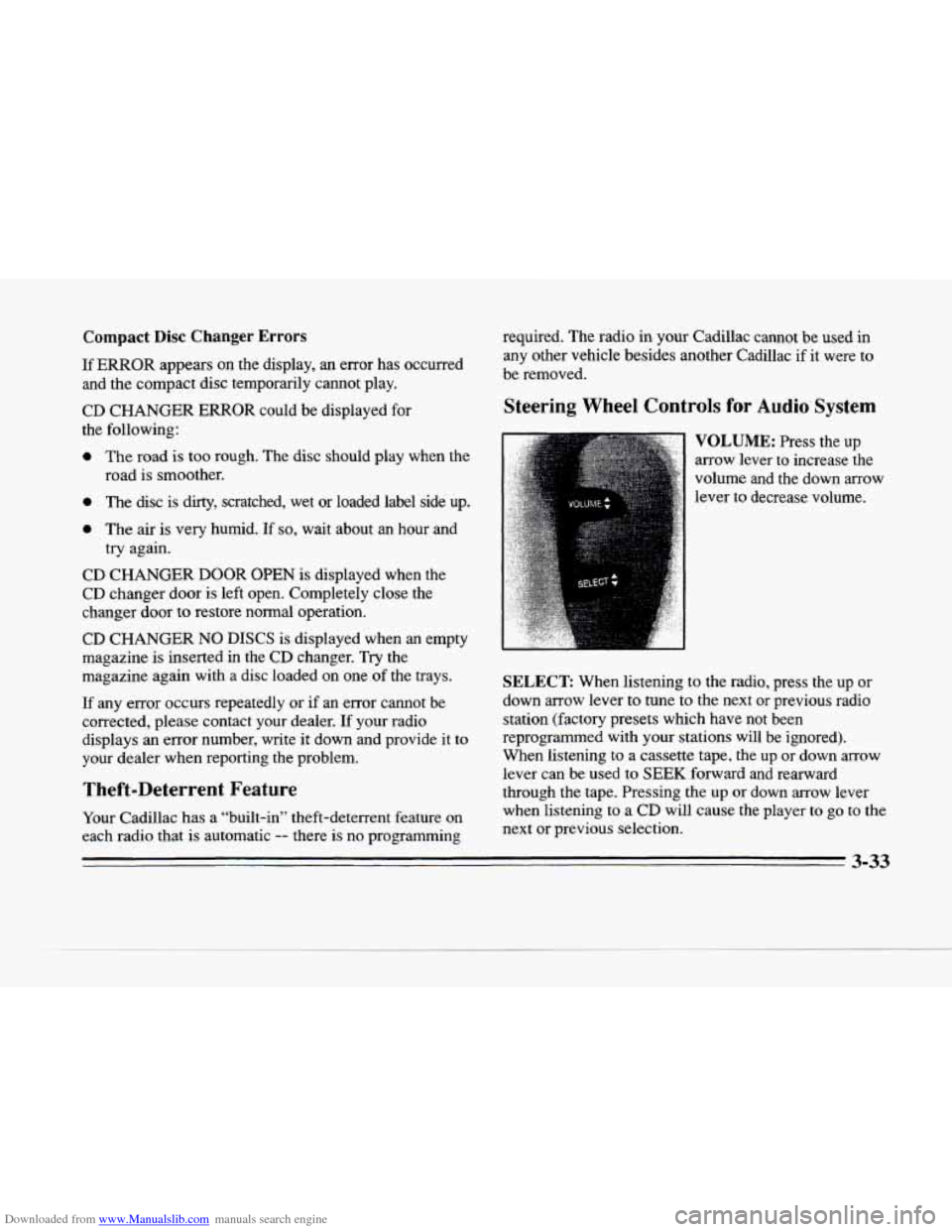
Downloaded from www.Manualslib.com manuals search engine c
L
II
c-
Compact Disc Changer Errors
If ERROR appears on the display, an error has occurred
and the compact disc temporarily cannot play.
CD CHANGER
ERROR could be displayed for
the following:
0 The road is too rough. The disc should play when the
road is smoother.
0 The disc is dirty, scratched, wet or loaded label side up.
0 The air is very humid. If so, wait about an hour and
CD CHANGER
DOOR OPEN is displayed when the
CD changer door is left open. Completely close the
changer door
to restore normal operation.
CD CHANGER
NO DISCS is displayed when an empty
magazine is inserted in the CD changer.
Try the
magazine again with
a disc loaded on one of the trays.
If any error occurs repeatedly
or if an error cannot be
corrected, please contact your dealer. If your radio
displays an error number, write it down and provide it to
your dealer when reporting the problem.
Theft-Deterrent Feature
Your Cadillac has a “built-in” theft-deterrent feature on
each radio that
is automatic -- there is no programming
try
again. required.
The radio
in your Cadillac cannot be used in
any other vehicle besides another Cadillac if it were to
be removed.
Steering Wheel Controls for Audio’ System
VOLUME: Press the up
arrow lever to increase the
volume and the down arrow
lever
to decrease volume.
SELECT When listening to the radio, press the up or
down arrow lever to tune to the next or previous radio
station (factory presets which have not been
reprogrammed with your stations will be ignored).
When listening to a cassette tape, the up
or down arrow
lever can be used to SEEK forward and rearward
through the tape. Pressing the up or down arrow lever
when listening to a
CD will cause the player to go to the
next or previous selection.
3-33
Page 182 of 354

Downloaded from www.Manualslib.com manuals search engine c
c
c
c
c
Care of Your Cassette Tape Player
A tape player that is not cleaned regularly can cause
reduced sound quality, ruined cassettes or a damaged
mechanism. Cassette tapes should be stored in their
cases away from contaminants, direct sunlight and
extreme heat.
If they aren’t, they may not operate
properly or may cause failure of the tape player.
Your tape player should be cleaned regularly after
every
50 hours of use. Your radio may display CLN or
CLEAN TAPE to indicate that you have used your tape
player for
50 hours without resetting the tape clean
timer. Each time the cassette is cleaned, the
50 hour
cassette timer should be reset. This is done by holding
down the eject button for five seconds or until the TAPE
CLEAN message
is displayed. If you notice a reduction
in
sound quality, try a known good cassette to see if the
tape or the tape player is at
fault. If this other cassette
has no improvement in sound quality, clean the
tape
player.
Cleaning may be done with
a scrubbing action,
non-abrasive cleaning cassette with pads which scrub
the tape head as
the hubs of the cleaner cassette turn.
It is normal for the cassette to eject while cleaning.
Insert the cassette at least six times to ensure thorough
cleaning. A scrubbing action cleaning cassette is
available through your Cadillac dealer.
You may also choose a non-scrubbing action, wet-type
cleaner which uses a cassette with a fabric belt to clean
the tape head. This type
of cleaning cassette will not
eject. It may not clean as thoroughly
as the scrubbing
type cleaner.
Cassettes
are subject to wear and the sound quality may
degrade over time. Always make sure that the cassette
tape is in good condition before you have your tape
player serviced.
Care of Your Compact Discs
Handle discs carefully. Store them in their original cases
or other protective cases and away from direct sunlight
and dust.
If the surface of a disc is soiled, dampen a
clean, soft cloth in a mild, neutral detergent solution and
clean
it, wiping from the center to the edge.
Be sure never to touch the signal surface when handling
discs. Pick up discs by grasping the outer edges or the
edge
of the hole and the outer edge.
3-35
Page 236 of 354

Downloaded from www.Manualslib.com manuals search engine L
rc
Engine Overheating
You will find an ENGINE COOLANT HOT-IDLE
ENGINE message
or a STOP ENGINE ENGINE
OVERHEATED message on the Driver Information
Center. There is also an engine temperature warning
light on the instrument panel. See “Engine Temperature
Warning Light”
in the Index.
Overheated Engine Protecaon Operating
Mode
Should a low coolant condition exist and the message
STOP ENGINE ENGINE OVERHEATED is displayed,
an overheat protection mode which alternates firing
groups
of four cylinders helps prevent engine damage.
This operating mode allows your vehicle
to be driven
to
a safe place in an emergency; you may drive up to
50 miles (80 km). Towing a trailer in the overheat
protection mode should be avoided.
NOTICE:
After driving in the Overheated Engine
Protection Operating Mode, to avoid engine
damage, allow the engine to cool before
attempting any repair. The engine oil may be
severely degraded. Change the
oil and reset the
oil life indicator. See “Engine Oil, When to
Change” in the Index.
5-15
Page 272 of 354
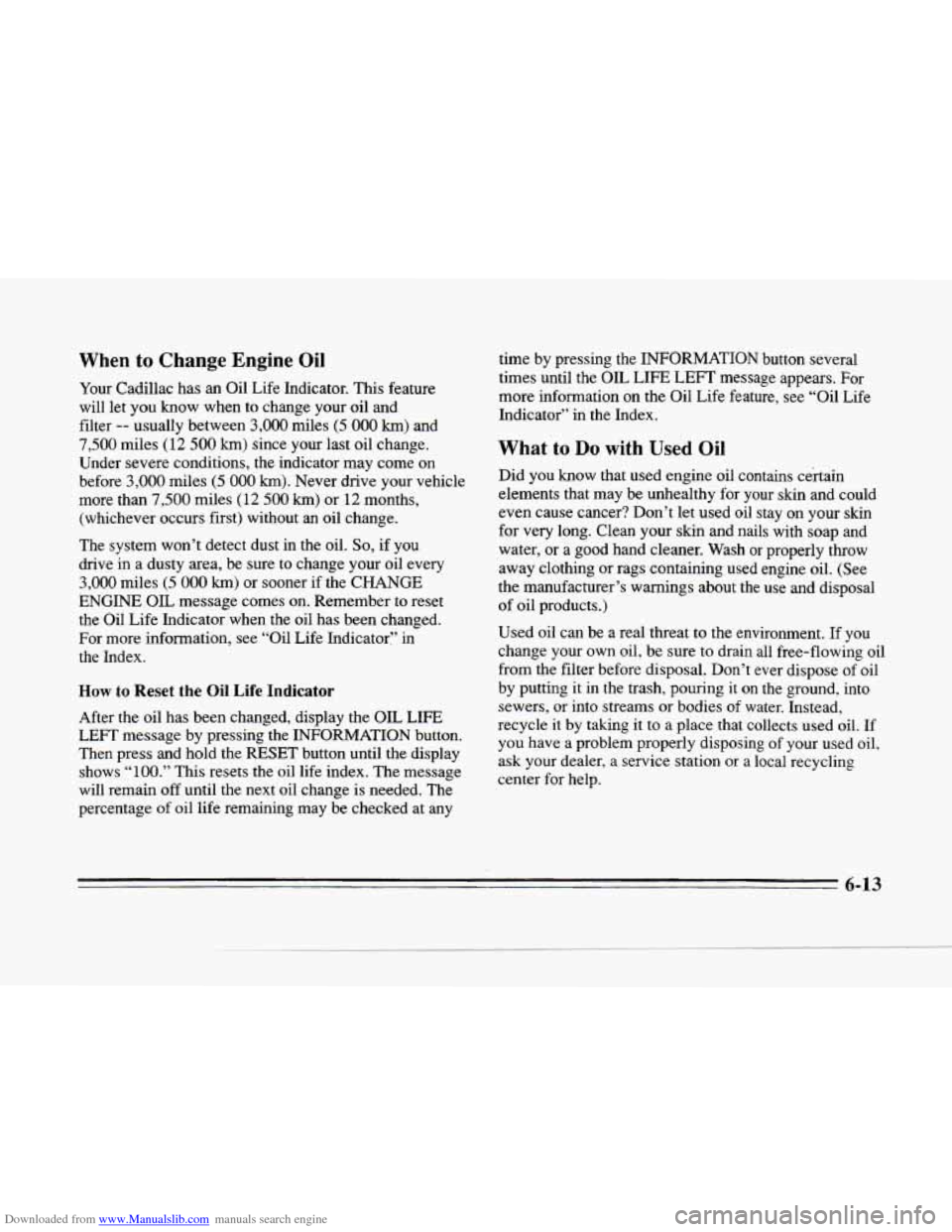
Downloaded from www.Manualslib.com manuals search engine When to Change Engine Oil
Your Cadillac has an Oil Life Indicator. This feature
will let you
know when to change your oil and
filter
-- usually between 3,000 miles (5 000 km) and
7,500 miles (12 500 km) since your last oil change.
Under severe conditions, the indicator may come
on
before 3,000 miles (5 000 km). Never drive your vehicle
more than
7,500 miles (12 500 km) or 12 months,
(whichever occurs first) without an oil change.
The system won’t detect dust in the oil.
So, if you
drive in a dusty area, be sure to change your oil every
3,000 miles (5 000 km) or sooner if the CHANGE
ENGINE
OIL message comes on. Remember to reset
the Oil Life Indicator when the oil has been changed.
For more information, see “Oil Life Indicator’’ in
the Index.
How to Reset the Oil Life Indicator
c”
After the oil has been changed, display the OIL LIFE
LEFT message by pressing the INFORMATION button.
Then press and hold the RESET button until the display
shows
“100.” This resets the oil life index. The message
will remain
off until the next oil change is needed. The
percentage of oil
life remaining may be checked at any time
by pressing the INFORMATION button
several
times until the OIL LIFE LEFT message appears. For
more information on the Oil Life feature, see “Oil Life
Indicator’’ in the Index.
What to Do with Used Oil
Did you know that used engine oil contains certain
elements that may be unhealthy for your skin and could
even cause cancer? Don’t let used oil stay on your
skin
for very long. Clean your skin and nails with soap and
water, or a good hand cleaner. Wash or properly throw
away clothing or rags containing used engine oil..(See
the manufacturer’s warnings about the use and disposal
of oil products.)
Used oil can be a real threat to the environment. If you
change your own oil, be sure to
drain all free-flowing oil
from the filter before disposal. Don’t ever dispose
of oil
by putting it in the trash, pouring it on the ground. into
sewers, or into streams
or bodies of water. Instead,
recycle it by taking
it to a place that collects used oil. If
you have a problem properly disposing of your used oil,
ask your dealer,
a service station or a local recycling
center for help.
6-13
Page 278 of 354
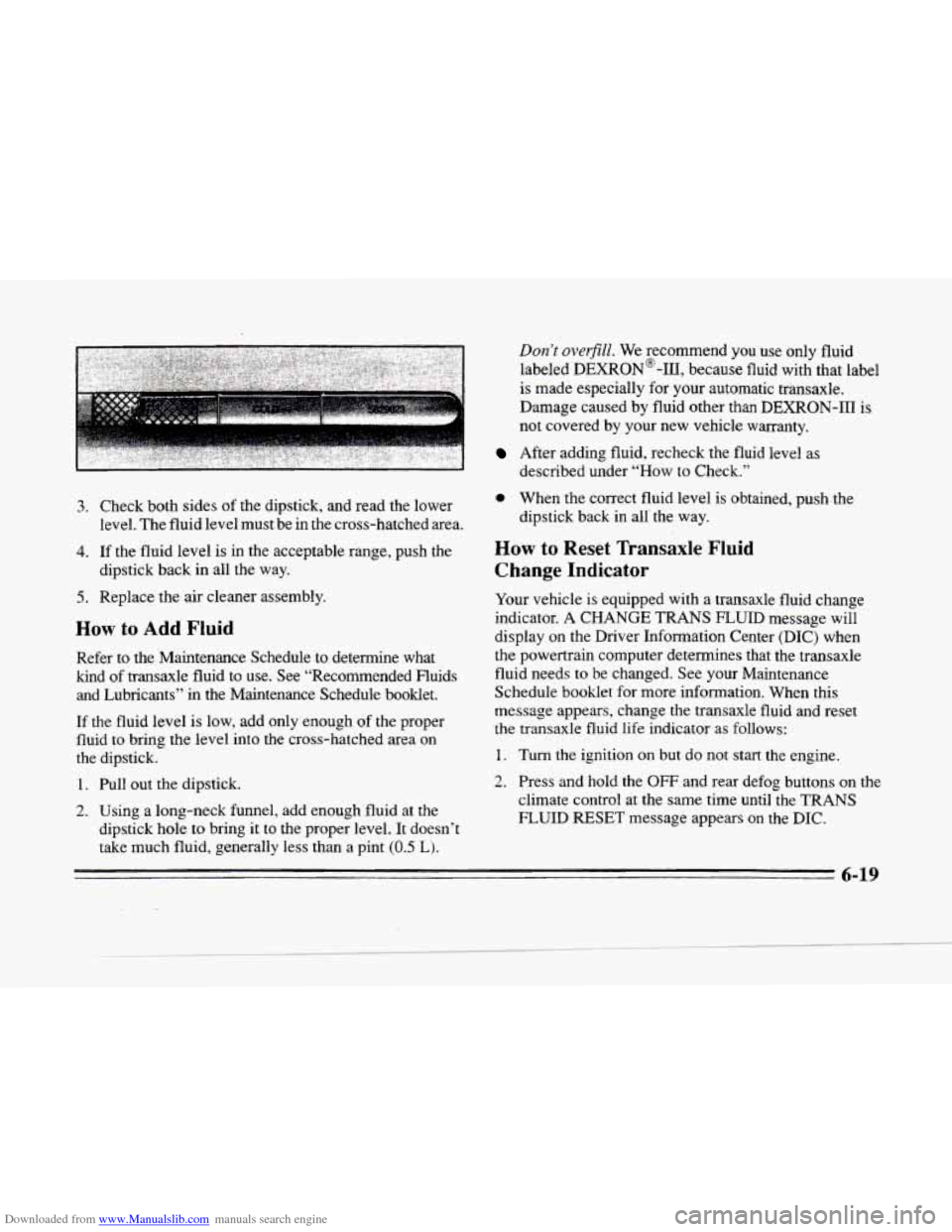
Downloaded from www.Manualslib.com manuals search engine c
3-
Don’t overfX We recommend you use only fluid
labeled DEXRON@-111, because fluid with that label
is made especially for your automatic transaxle.
Damage caused by fluid other than DEXRON-III is
not covered by your new vehicle warranty.
After adding fluid, recheck the fluid level as
described under “How to Check.”
3. Check both sides of the dipstick, and read the lower
level. The fluidlevel must be
in the cross-hatched area.
4. If the fluid level is in the acceptable range, push the
dipstick back
in all the way.
5. Replace the air cleaner assembly.
How to Add Fluid
Refer to the Maintenance Schedule to determine what
kind
of transaxle fluid to use. See “Recommended Fluids
and Lubricants”
in the Maintenance Schedule booklet.
If the fluid level is low, add only enough of the proper
fluid
to bring the level into the cross-hatched area on
the dipstick.
1. Pull out the dipstick.
2. Using a long-neck funnel, add enough fluid at the
dipstick hole
to bring it to the proper level. It doesn’t
take much fluid, generally less than a pint (0.5 L).
0 When the correct fluid level is obtained, push.the
dipstick back
in all‘ the way.
How to Reset Transaxle Fluid
Change Indicator
Your vehicle is equipped with a transaxle fluid change
indicator.
A CHANGE TRANS FLUID message will
display on the Driver Information Center (DIC) when
the powertrain computer determines that the transaxle
fluid needs to be changed. See your Maintenance
Schedule booklet for more information. When this
message appears, change the transaxle fluid and reset
the transaxle fluid life indicator as follows:
1. Turn the ignition on but do not start the engine.
2. Press and hold the OFF and rear defog buttons on the
climate control at the same time until the TRANS
FLUID
RESET message appears on the DIC.
6-19
Page 282 of 354

Downloaded from www.Manualslib.com manuals search engine Y
Adding Coolant
If you need more coolant, add the proper mix at the
surge tank, but only when the engine is cool.
I A CAUTION:
You can be burned if you spill coolant on hot
engine parts. Coolant contains ethylene glycol,
and it will burn if the engine parts are hot
enough. Don’t spill coolant on
a hot engine.
c1
When replacing the pressure cap, make sure it is tight.
Surge Tank Pressure Cap
I NOTICE:
.-
The surge tank cap is a 15 psi (105 kPa) ’
pressure-type cap and must be tightly installed to
prevent coolant loss and possible engine damage
from overheating. Be sure the arrows on the
cap line up.
If the surge tank pressure cap needs to be replaced, a
General Motors cap is recommended.
Thermostat
Engine coolant temperature is controlled by a thermostat
in the engine coolant system. The thermostat stops
the
flow of coolant through the radiator until the coolant
reaches a preset temperature.
If your thermostat needs to be replaced, a General
Motors thermostat
is recommended.
6-23